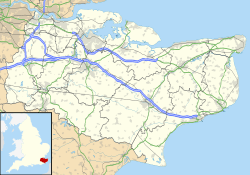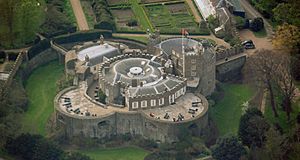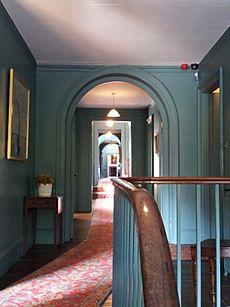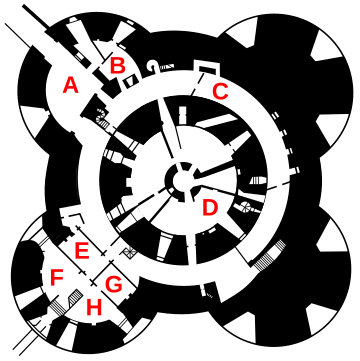Walmer Castle facts for kids
Quick facts for kids Walmer Castle |
|
|---|---|
| Walmer, England | |
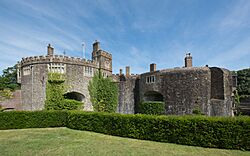
The castle from the east in 2018
|
|
| Coordinates | 51°12′04″N 1°24′08″E / 51.200992°N 1.402308°E |
| Type | Device Fort |
| Site information | |
| Owner | English Heritage |
| Open to the public |
Yes |
| Site history | |
| Built | 1539 |
| Events | English Civil War Napoleonic Wars |
| Official name | Artillery castle at Walmer |
| Designated | 19 October 1981 |
| Reference no. | 1013381 |
| Official name | Walmer Castle |
| Designated | 1 May 1986 |
| Reference no. | 1000291 |
Walmer Castle is an old fort built by King Henry VIII in Walmer, Kent, between 1539 and 1540. It was part of the King's plan to protect England from attacks by France and the Holy Roman Empire. The castle helped defend an important area called the Downs, where ships could safely anchor off the English coast.
The castle has a main tower, called a keep, and four round towers, known as bastions. It is surrounded by a moat (a deep ditch, often filled with water). The stone castle covered about 0.61 acres and had 39 places on its upper levels for cannons. Walmer, along with two other nearby castles, Sandown and Deal, cost the King about £27,092 to build. These three castles were connected by earth walls.
The threat of invasion passed, but Walmer Castle became important again during the Second English Civil War in 1648–49. It was taken over by people who supported the King, but was later won back by Parliament's forces after several months of fighting.
In the 1700s, Walmer Castle became the official home of the Lord Warden of the Cinque Ports. This was an important job, and over time, the castle changed from a military fort into a private house. Many famous people, including Prime Ministers like William Pitt the Younger and the Duke of Wellington, lived there. They added living spaces and created beautiful gardens around the castle.
By 1904, the army decided Walmer Castle was no longer needed for military purposes. It was then looked after by the government's Ministry of Works. Lord Wardens continued to use the castle, and it was also opened to the public. Today, Walmer Castle is a popular place for tourists, managed by English Heritage. Inside, you can see historical items and pictures related to the castle and its famous residents. The gardens include the Queen Mother's Garden, which was a gift for Queen Elizabeth The Queen Mother's 95th birthday in 1997.
History of Walmer Castle
Building the Castle in the 1500s
Walmer Castle was built to protect England from attacks by France and the Holy Roman Empire (a large group of states in central Europe). This happened in the last years of King Henry VIII's rule. Before this, England mostly relied on local lords to defend the coast.
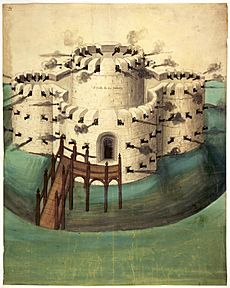
In 1533, King Henry VIII decided to end his marriage to Catherine of Aragon. This made Charles V, Holy Roman Emperor, Catherine's nephew, very angry. In 1538, France and the Holy Roman Empire formed an alliance against Henry, and the Pope encouraged them to attack England. It looked like an invasion was coming.
To prepare, King Henry issued a special order in 1539. This order, called a "device," gave instructions to build forts along the English coast to defend the country from invasion.
Walmer Castle, along with Deal and Sandown castles, was built to protect the Downs in Kent. This was an important area where enemy soldiers could easily land on Deal Beach. These stone castles were also supported by four earth forts and a 2.5-mile-long defensive ditch. Together, these became known as the "castles of the Downs."
Walmer Castle was built between April 1539 and autumn 1540. It was built by a team that included Richard Benese (surveyor), William Clement (master carpenter), and Christopher Dickenson (master mason). The castle was first guarded by a captain, two lieutenants, two porters, ten gunners, and three soldiers. It had various types of cannons and smaller guns for close defense.
Walmer Castle in the 1600s
In the early 1600s, Walmer Castle was not well maintained. Not much money was spent on repairs, and the soldiers guarding it were paid very little.
At the start of the first English Civil War, Walmer Castle was taken by Parliament's forces. This war was fought between supporters of King Charles I and Parliament. Walmer Castle did not play a big role in this first part of the war.
However, in 1648, the Second English Civil War began. This time, the King's supporters were joined by Scottish allies. The Parliament's navy was based in the Downs, protected by Walmer and the other castles. But in May, people in Kent who supported the King started a rebellion.
Walmer and Deal Castles declared their support for the King, soon after Sandown Castle did the same. With both the forts and the navy under the King's control, Parliament worried that foreign armies might land along the coast.
Parliament defeated the main rebellion in June. Then, they sent a force led by Colonel Nathaniel Rich to deal with Walmer and the other castles. Walmer Castle was attacked first and surrendered on July 12. Deal was attacked later in July, and Sandown in August. Walmer was badly damaged during the fighting, and it cost at least £500 to repair.
After the war, in 1649, Parliament sent new supplies to Walmer and the other castles, making them ready again. The castle had a governor, a corporal, and 20 soldiers. When King Charles II returned to the throne in 1660, he reduced the number of soldiers. In 1688, during the Glorious Revolution against King James II, the people of Deal took Walmer Castle for William III. By the end of the century, the castle was seen as old-fashioned for military use.
Walmer Castle in the 1700s and 1800s
Becoming a Home (1700–1828)
In the 1700s, Walmer Castle became the official home of the Lord Warden of the Cinque Ports. This was an old title for someone in charge of five important ports along the English coast. The Duke of Dorset, who became Lord Warden in 1708, decided to live at Walmer Castle instead of Dover Castle, which was falling apart.
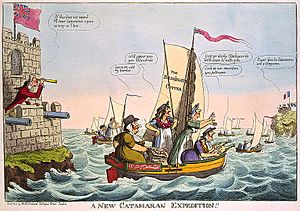
The Duke made many changes to make the castle more comfortable to live in. Later Lord Wardens continued to keep cannons at the castle, but it became less and less like a military fort.
William Pitt the Younger, who later became Prime Minister, was made Lord Warden in 1792. Pitt used the castle a lot, and by 1803, it was his main home. His niece, Lady Hester Stanhope, helped him transform the castle gardens from a simple vegetable patch into beautiful ornamental gardens. She even got soldiers from Dover to help with the planting.
When the French Revolutionary Wars began, Pitt became very involved in protecting the coast. He often hosted military commanders and naval captains at Walmer. After he stopped being Prime Minister in 1801, he formed a volunteer cavalry unit and a fleet of 35 fishing boats armed with cannons, which he reviewed from the castle.
Robert Jenkinson, 2nd Earl of Liverpool, took over Walmer Castle after Pitt died in 1806. As Prime Minister, Liverpool used Walmer as a quiet place to relax and to have private political talks with special guests.
The Duke of Wellington and Others (1829–1899)
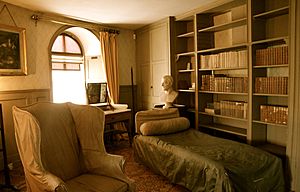
When Lord Liverpool died in 1828, Arthur Wellesley, 1st Duke of Wellington, who was then Prime Minister, asked King George IV for the job of Lord Warden because he wanted to live at Walmer Castle. Wellington moved in in 1829 and loved Walmer, calling it "the most charming marine residence." He visited the castle every autumn, hosting many guests but living and sleeping in just one room. Queen Victoria visited him there twice.
The Duke of Wellington died in his room at Walmer Castle on September 14, 1852. His body was kept in his room for people to visit until November 10. About 9,000 people came to see it during the last two days.
After Wellington, James Broun-Ramsay, 1st Marquess of Dalhousie, became Lord Warden. When he died, Prime Minister Henry John Temple, 3rd Viscount Palmerston, took over the castle in 1861.
Granville Leveson-Gower, 2nd Earl Granville, became Lord Warden in 1865. He expanded the gardens and spent many years collecting back the furniture and items that Pitt and Wellington had used at the castle. He had many visitors, especially those traveling to or from France. A diplomat named Baron de Malortie visited Granville and his family at Walmer and said the castle felt very homely. He described how everyone would gather in the drawing room, the only large room, and Granville would work on government letters while family life went on around him.
William Smith was appointed Lord Warden in 1891 but died at Walmer Castle during his first visit. Smith had suggested that the historical items in the castle should be protected so they wouldn't be removed by future Lord Wardens. The government agreed after his death, protecting almost 70 pieces of furniture and 50 artworks. Robert Gascoyne-Cecil, 3rd Marquess of Salisbury, became the next Lord Warden.
Walmer Castle in the 1900s and 2000s
By 1904, the army decided Walmer Castle was no longer useful for military purposes. They agreed to give the castle to the Office of Works, a government department that looked after public buildings. The Office of Works noted that the castle was "very inconvenient, dark and not conducive to health" and suggested it might be better to knock it down and rebuild it.
However, the castle was not demolished. Instead, most of it was opened to the public, with historical items on display. Lord Curzon moved into the castle in 1905. His wife, Mary, became ill, and Curzon believed it was because of their poor living conditions. She died shortly after. Because of this, Curzon resigned, and the Prince of Wales, who later became King George V, took over the role.
William Lygon, 7th Earl Beauchamp, became Lord Warden in 1913. He built a small chapel at the castle and held large parties there. His children later said the castle was cold and cramped. During the First World War, Prime Minister H. H. Asquith was invited to use the castle as a weekend retreat because it had good connections to the front lines in France. Asquith's wife, Margot, at first found Walmer "terribly exposed" with "cold... noisy corridors and small rooms," but she later grew to like it.
Rufus Isaacs, 1st Marquess of Reading, became Lord Warden in 1934. His wife, Stella, tried to make Wellington's old bedroom look as it did when he lived there. The 4th Duke of Wellington agreed to send the original items from the room back to the castle, where they still are today.
Freeman Freeman-Thomas, 1st Marquess of Willingdon, became Lord Warden in 1936, followed by Sir Winston Churchill in 1941 during the Second World War. Churchill told the Minister of Works that he doubted he could live at Walmer Castle during the war because it was within range of German cannons on the French coast. He hoped the government would maintain the castle and gardens.
Sir Robert Menzies, an Australian politician, became Lord Warden in 1965 and visited the castle every year. Queen Elizabeth The Queen Mother followed Menzies in 1978. She would visit the castle from the Royal Yacht HMY Britannia, and from 1986 onwards, she would take over the entire castle for three days each July. This meant moving furniture and other items from London, which was a challenge for English Heritage, who managed the property. Admiral of the Fleet Michael Boyce, Baron Boyce, became Lord Warden in 2004. After his death in 2022, the position was empty until June 2024, when Sir George Zambellas became the current Lord Warden.
Today, Walmer Castle is managed by English Heritage. In 2019, it attracted 152,391 visitors. English Heritage made improvements to the castle in 2015 to make the visitor experience better. The castle is protected by UK law as a scheduled monument, and its gardens are also protected.
Castle Architecture
Inside the Castle
Walmer Castle still has most of its original 16th-century design. It has a tall keep (main tower) in the middle, about 83 feet across. Four round towers, called bastions, are on each side. One of these bastions serves as the gatehouse (entrance). A moat surrounds the castle, which is then surrounded by an outer wall. The castle's curved walls are 15 feet thick. It was very similar to Sandown Castle and covered about 0.61 acres.
The castle had three levels for cannons, with the biggest and longest-range weapons on the upper levels, including the keep. There were 39 firing positions in total. There were also 31 small openings in the basement for handguns, for close defense. The openings in the walls were wide to allow the guns to move easily, and the inside of the castle had vents to let out smoke from the cannons.
From the 1700s onwards, the inside of the castle was changed to create living spaces for the Lord Wardens. Most of these rooms are now open to visitors. You still enter the castle through the ground floor of the gatehouse. In the middle of the castle is the keep, which used to be the Servants' Hall and is now a tea room.
In the southern tower, there are rooms that were originally built for gunners in the 1700s. These were later changed into the castle's entrance hall in the 1930s. The Sackville and Willingdon Rooms were also built in the 1700s. The Willingdon Room is now a museum for items related to William Pitt. The Lucas Room is decorated in a style from the mid-1800s and displays items belonging to the Duke of Wellington.
The second floor has the Lord Warden's private rooms. The Duke of Wellington's Room and the Lucas Room are in the southern tower. These were part of the rooms William Pitt chose because they were the warmest in the castle. A corridor running through the castle was built by Pitt to connect the north and south parts of the castle.
The Prince Consort's and Queen Victoria's rooms are named after their visit in 1842. The Dining Room, Drawing Room, and Ante Room, which look out over the northern tower, were built in the 1730s. These rooms have pink and purple window glass. Some of this glass changed color naturally over time, while other panes were bought around 1800 for their color, perhaps as a sign of wealth.
Walmer Castle Gardens
The gardens at Walmer Castle mostly date from the 1790s and 1860s. They cover about 13 hectares (about 32 acres) of land, split between formal gardens and open parkland. The main part of the gardens stretches away from the castle towards the north-west. The soil is well-drained and chalk-based, creating a special climate near the sea.
You approach the castle through the castle meadow, an open area with Holm oaks planted in the 1860s. The castle is surrounded by a dry moat, which is now a garden with trees and shrubs. Next to the castle are the Queen Mother's Garden and the kitchen garden with glasshouses. The Queen Mother's Garden was created by English Heritage as a 95th birthday gift for the Queen Mother in 1997. It used to be part of the kitchen gardens and later a tennis court. This garden has a 92-foot-long pool, a viewing mound, and a classical pavilion. The two glasshouses have been restored and are used as cold greenhouses, while the rest of the kitchen garden grows vegetables, fruit trees, and flowers.
The 262-foot-long Broadwalk is the main path in the gardens. It separates the glasshouses from the 328-foot-long Oval Lawn, which has lime trees and yews. The Broadwalk is lined by the "Cloud Hedge," a formal yew hedge from the 1800s that grew very large during the Second World War and was shaped into its current wavy style. Two terraces in the middle of the garden separate the far half of the garden. Beyond them are a paddock with Holm oaks and a curved area of woodland with beech, ash, and chestnut trees. At the very end is the Glen, a wooded hollow that was once an old chalk quarry.
See also
 In Spanish: Castillo de Walmer para niños
In Spanish: Castillo de Walmer para niños


